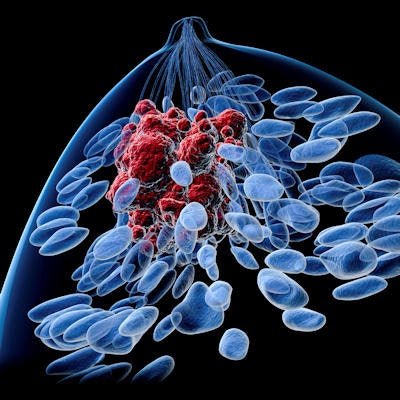
Women who got ultrasound scans had lower rates of recurrence-free survival compared with women who received mammography in patients treated for asymptomatic ductal carcinoma in situ (DCIS) in a new study, published online July 24 in Ultrasound in Medicine and Biology.
The study findings are surprising and suggest that further investigation is needed, wrote a team led by Dr. Jung Hyun Yoon of Yonsei University in Seoul, Korea. Since microcalcifications on mammography often predict the aggressiveness of DCIS, there may be another, as yet unknown factor to be discovered for ultrasound-detected DCIS.
"Further multifactorial investigation is needed to validate our results and will hopefully include factors of a genetic basis," the group wrote.
Heated debate
Heated debate continues on how best to handle DCIS, as it is uncertain whether it will develop into invasive cancer. In fact, some estimate that 47% to 86% of diagnosed DCIS will not become invasive, Yoon's group noted.
"Since it is unclear which patients diagnosed with DCIS will progress into fatal conditions, low-risk DCIS has been treated with multimodal surgical and radiation therapy, treatment approaches equal to those for high-risk DCIS or invasive cancers," the team wrote.
But whether the survival benefits of these aggressive treatment approaches are effective hasn't been established, and data are lacking on patient outcomes or characteristics of DCIS based on the imaging modality used to identify it, according to the group.
"The sole purpose of screening for breast cancer is to detect cancers at a more treatable stage, and if DCIS has different final outcomes according to detection modality, the detection modality itself may be a factor in deciding further aggressive treatment," the team wrote.
The researchers sought to address this knowledge gap with a study that included 844 women treated for asymptomatic DCIS who had preoperative mammography and ultrasound exams between February 2003 and February 2011. The women who participated in the study had been diagnosed with pure primary DCIS according to histopathology results from surgery, followed up after treatment (mean follow-up time: 91 months), and had no invasive breast cancer or DCIS before or within six months after being diagnosed. Treatment consisted of either total mastectomy (38.5%) or breast-conserving surgery with radiation (61.5%).
Eight radiologists retrospectively reviewed the mammography and ultrasound exams. Mammography exams were categorized by density according to the BI-RADS system, and findings were categorized by characteristic (calcifications with mass, asymmetry, or distortion; and mass, asymmetry, or distortion without calcifications). Ultrasound findings were classified as mass or nonmass lesions.
The women were divided into two groups: 744 were in a group with DCIS detected on mammography regardless of ultrasound findings, and 100 were in a group with DCIS detected on ultrasound only. Yoon and colleagues found that of the 744 women in the mammography group, 82.1% had microcalcifications found on mammography.
During the follow-up period, 25 of the 844 women developed recurrences. Of these recurrences, 24% were in patients who had ultrasound-detected DCIS. Women in the ultrasound group had lower recurrence-free survival rates than those in the mammography group: of the 25 recurrences, 19 patients were in the mammography group (2.6% of 744 patients) and six were in the ultrasound group (6% of 100 patients).
Yoon and colleagues also found that women with ultrasound-detected DCIS had lower recurrence-free survival rates compared with mammography among those younger than 50 and those with mammographically dense breasts.
| DCIS survival rates by characteristic and modality | ||
| Characteristic | Mammography | Ultrasound |
| 5-year recurrence-free survival rate | ||
| Overall | 98.9% | 95.6% |
| Women under 50 years of age | 98.1% | 95.2% |
| Mammographically dense breasts | 98.8% | 95.3% |
| 10-year recurrence-free survival rate | ||
| Overall | 96.1% | 84% |
| Women under 50 years of age | 96.2% | 77.5% |
| Mammographically dense breasts | 96.7% | 79.7% |
Finally, Yoon's team found that ultrasound as the detection modality for DCIS was a significant factor associated with tumor recurrence, with a hazard ratio of 4.45.
"Based on our results, we conclude that asymptomatic DCIS detected only on screening ultrasound had poorer outcomes after treatment compared with DCIS detected on mammography," the authors wrote.
Why the discrepancy?
The reasons for the lower recurrence-free survival rates and the association with post-treatment recurrence in DCIS detected on ultrasound only remain unclear, according to the researchers. The presence of microcalcifications is associated with DCIS or invasive cancer recurrence, and in fact, the team expected lower recurrence-free survival rates in the mammography group, due to detectable microcalcifications.
But this did not prove to be the case, leading the authors to hypothesize that lower recurrence-free survival rates for ultrasound-identified DCIS may be due to a factor that hasn't yet been established, such as activated cancer-associated fibroblasts, which are part of the tumor's microenvironment.
"Activated cancer-associated fibroblasts are known to be associated with tumor aggressiveness, progression, and metastatic activity in several epithelial cell origin cancers, which may be the explanation for the poor outcomes of DCIS in the ultrasound group, since DCIS in this group do not have suspicious microcalcifications," the team concluded.




















